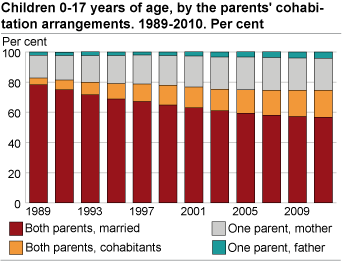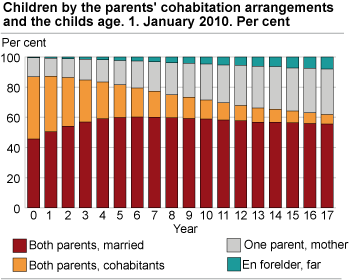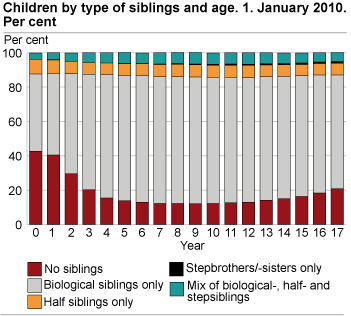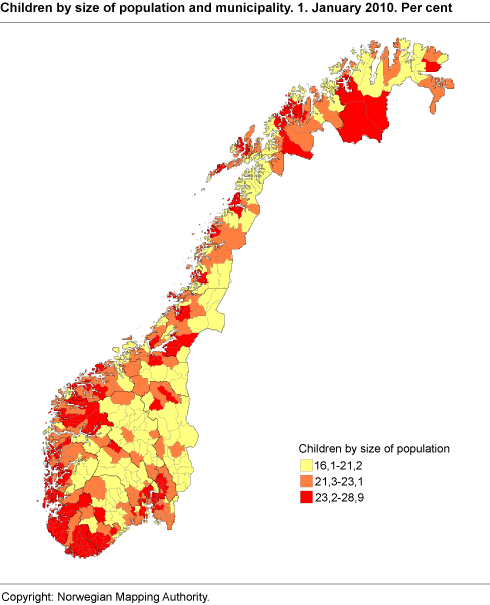Content
Published:
This is an archived release.
Only six out of ten have married parents
At the turn of the year, 1.1 million children in Norway under 18 years old were living at home with their parents. 57 per cent of these children lived with married parents.
The proportion of children living with married parents is decreasing. Since 1989, which was the first year the children statistics were published, the share of children below 18 years of age living with both parents has decreased from 83 to 75 per cent. The decrease has been even larger for the proportion of children living with married parents - from 78 to 57 per cent. During the same period, the share of children living with cohabiting parents has increased from 5 to 18 per cent. The proportion of children living with married parents is lowest among children less than one year old. Less than half the children in this age group live with married parents. The share is gradually increasing to 60 per cent among children in the age group 5-8 years old, but is decreasing slightly as from this age.
Few 17-year-olds with cohabitating parents
The percentage of children living with cohabitant parents is at its highest amongst children less than one year old. Four out of ten children in this age group live with cohabitating parents. This percentage decreases gradually for the older children. Amongst children 17 years old, only 6 percent live with cohabitating parents. There are several reasons for this. 17 years ago it was more common for parents to get married instead of living together in a consensual union. Furthermore, some parents decide to get married after some years in a consensual union. Finally, some children experience parents moving apart. Because of this, we can observe a gradual increase in the number of children living with one parent only among the older children. These conditions are also reflected in the average age of the children. Children living with married parents are averagely three years older than children living with cohabiting parents. Children living with only one of their parents are in average one year and nine months older than those living with married parents.
Nine out of ten live with siblings
The percentage of children living with siblings is highest among children nine years old. In this age group, nine out of ten children live with siblings. The majority of these children, 84 per cent, live with their biological siblings only. The percentage of children living with sibling is at the lowest among the youngest children. Among children less than one year old, only 57 per cent live with siblings. Many of them will, however, get siblings as time goes by. As from the age of ten, the percentage of children living with sibling is decreasing slightly because older siblings tend to move out.
Fewer children inland
We find the municipalities with the lowest shares of children compared to the total population in the inland part of Sothern Norway, and in Oslo. Furthermore a lot of the municipalities in Northern Norway have low shares of children. The highest shares of children we find in the municipalities surrounding the largest cities. In addition we find high shares of children in the coastal area of South West Norway.
|
In these statistics, children are defined as persons aged 0-17 years who are registered as living with at least one parent. Persons aged 0-17 years who do not live at home are not included. Persons who got married or gave birth before the age of 18 are also not included. |
Tables:
- Table 1 Children 0-17 years, by number of parents in the family, the parents' cohabitation arrangements and the child's age. Per cent. 2001, 2005-2010
- Table 2 Children 0-17 years, by number of parents in the family, the parents' cohabitation arrangements, siblings living at home and the child's age. 2001, 2005-2010
- Table 3 Children 0-17 years, by number of parents in the family, the parents' cohabitation arrangements and county. 2001, 2005-2010. Per cent
- Table 4 Children 0-17 år, by type of siblings living at home and the child's age. Per cent. 2001, 2005-2010
- Table 5 Children 0-17 år, by type of siblings living at home and county. Per cent. 2001, 2005-2010
- Table 6 Children 0-17 years, by number of siblings and parents living at home and the parents' cohabitation arrangements. Per cent. 2001, 2005-2010
- Table 7 Children 0-17 years, by number of siblings and county. Per cent. 2001, 2005-2010
- Table 8 Children 0-17 years, by number of siblings and the child's age. Per cent. 2001, 2005-2010
The statistics is published with Families and households.
Contact
-
Statistics Norway's Information Centre
E-mail: informasjon@ssb.no
tel.: (+47) 21 09 46 42




